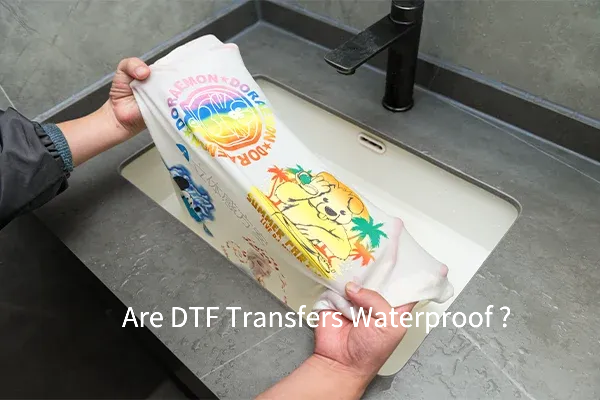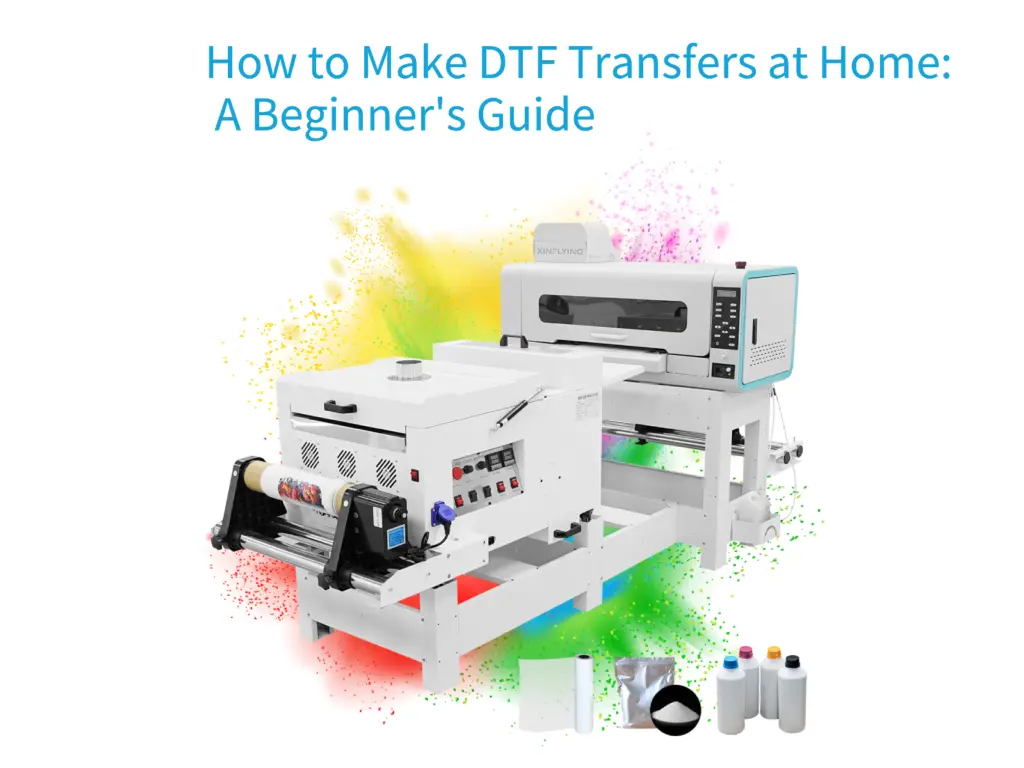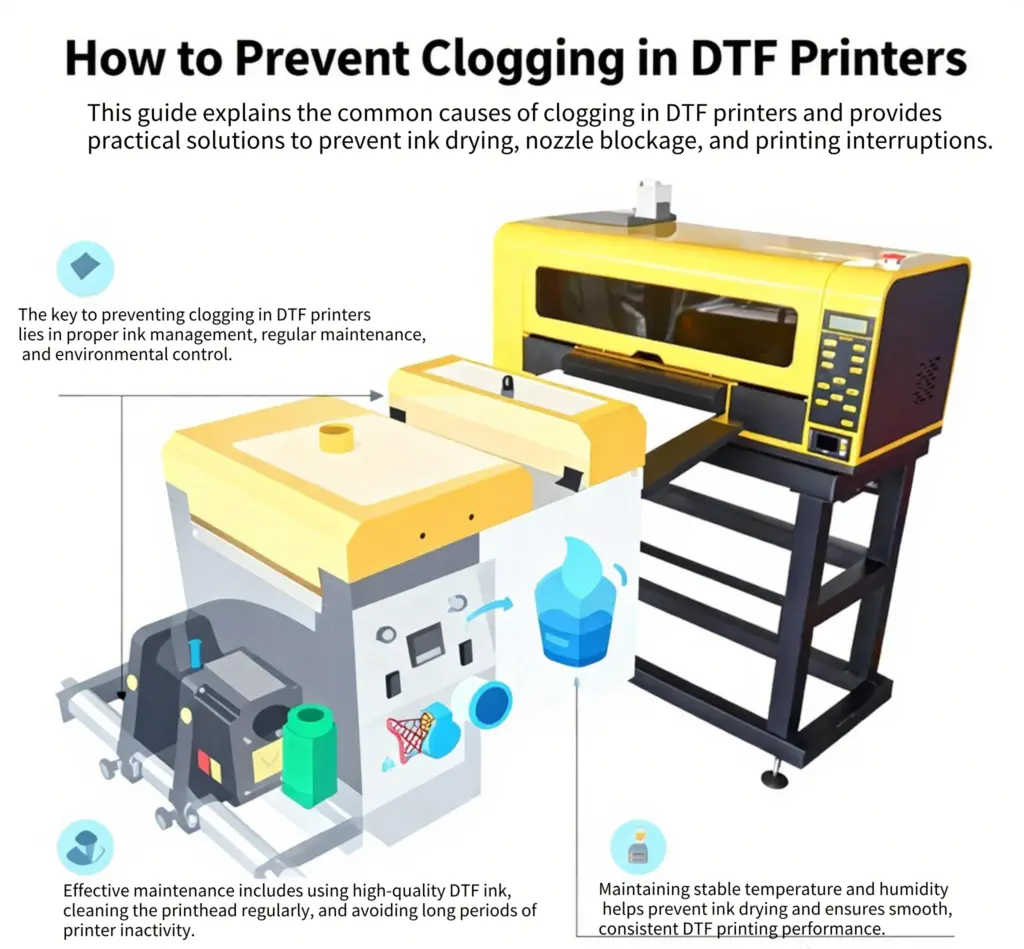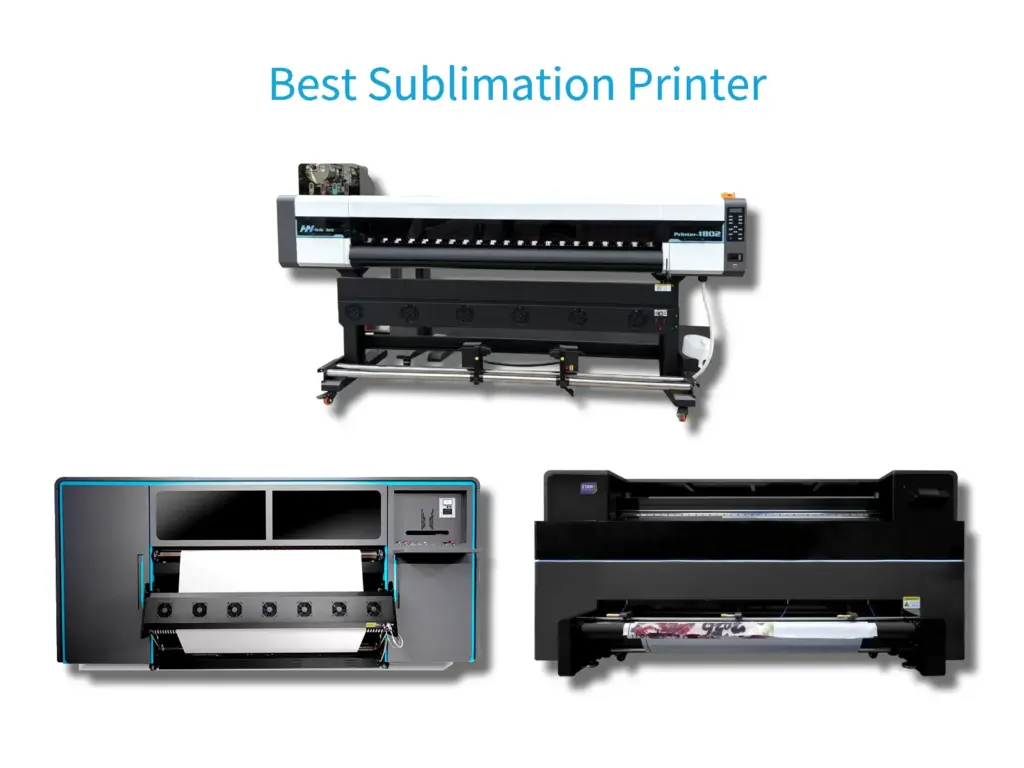Oq siyoh raqamli transfer (DTF) bosib chiqarish taxminan yigirma yil ichida deyarli ikki o'n yillikda bo'ldi, Nisbatan yangi texnologiyaga aylantirish. Yoshligiga qaramay, U butun sanoatni sezilarli darajada ta'sir qildi. Keng tarqalgan, DTF texnologiyasining keng tarqalganligi, nafas olish sur'atida bozor o'sishini kuchaytirdi. Hali, Ushbu tez o'sish sanoat musobaqasini kuchaytirmoqda.
DTF bozorining rivojlanishi
Ga binoan Klaviaturaning razvedkasi bo'yicha hisobot, DTF-ni bosib chiqarish hajmi 2022 atrofida baholandi 1.9 milliard kvadrat metr. Bilan 2027, Bu raqam taxminan pasayishi kutilmoqda 10 milliard kvadrat metr.
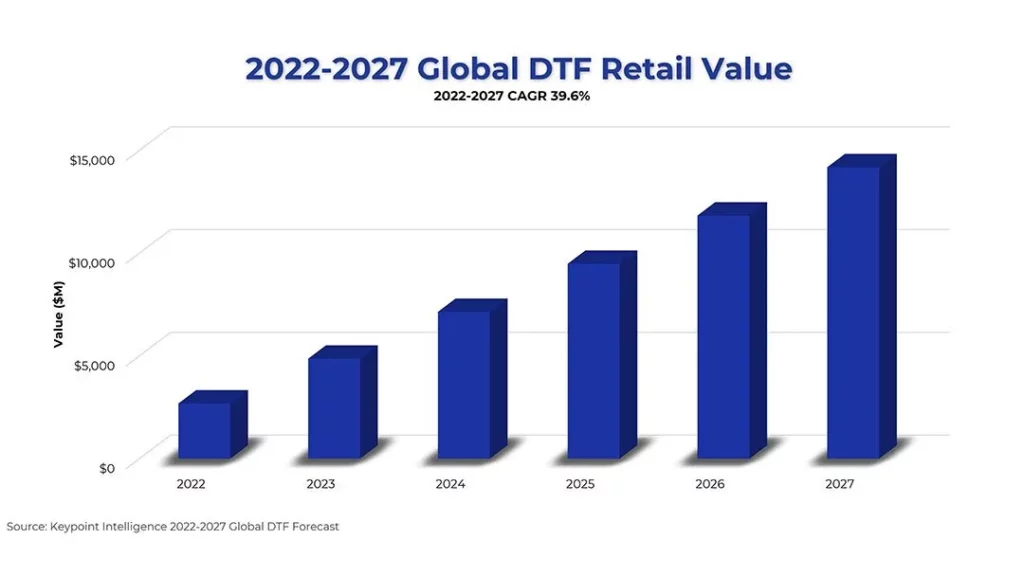
Bozor qiymati nuqtai nazaridan, Hisobot shuni nazarda tutadi DTF bozorining chakana qiymati edi $2.78 milliard 2022. Bilan 2027, Bu raqam ajoyib narsaga erishish uchun rejalashtirilgan $14 milliard. Hisobot shunga o'xshash narsalar “DTF asrab olish stavkalari kiyim-kechak sanoatida misli ko'rilmagan. Ichida 2022, DTF qurilmalari haqida hisobga olingan 44.5% barcha dtf, to'g'ridan-to'g'ri kiyim (DTG), Qurilmalar qurilmalarini uzatish. Bilan 2027, DTF printerlari tuzilishi kutilmoqda 64.4% bunday installatlar.”
Hisobot shuningdek, eslatma Taxminan bor edi 9,082 DTF qurilmalari dunyo bo'ylab 2022. Bu raqam deyarli o'sishi kutilmoqda 15,000 bilan 2027, bilan DTU-bosh dtf printer mashinalar Bozorda hukmronlik qilish, va to'rt bosh dtf printerlari bozor ulushining chorak qismidan iborat.
DTF hali ham foyda keltirishi mumkin?
Ushbu tendentsiyalarni hisobga olgan holda, Birinchidan hayron bo'lishi mumkin: DTF hali ham foyda keltirishi mumkin? Qisqa va aniq javob: Ha. Biroq, Bosma xizmat ko'rsatuvchi provayderlar uchun (Psps) Uzoq muddatli rentabellik va yuqori marjalarga erishish, Ular xizmat takliflari va ishlab chiqarishda DTF-ni bosib chiqarish usuli kerak.
Yaqin o'tkan yillarda, DTF mashinalaridan foydalanish imkoniyati bozorning o'sishi. Xitoyda arzon uskunalarning echimlari deyarli har kim mijozlarga DTF xizmatlarini taklif qilishi mumkinligini anglatadi. Bu biznesni diversifikatsiya qilishni qidirayotgan biznes uchun juda yaxshi, Shuningdek, u bozorni to'yintirishga olib keldi.
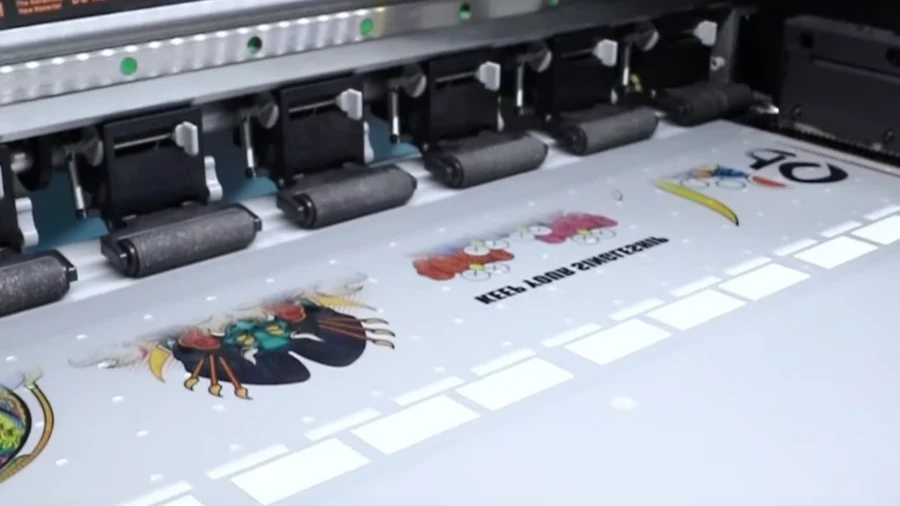
Asosiy plitaning razvedkasi to'g'risidagi hisobot to'g'ridan-to'g'ri ushbu masalaga murojaat qiladi, buni ta'kidlash “DTF bozori hali ham erta bosqichda, apparat etkazib beruvchilari orasida sezilarli tartibsizliklar bilan. Uning rivojlanishi yo'lini DTGning erta rivojlanishi aks ettiradi.”
Shunday qilib, Qanday qilib raqobatdan ajralib turishi va qimmatli mijozlarni jalb qilishi mumkin? Javob oddiy: Xizmatni yaxshiroq taklif qiling.
Yuqori sifatli talablarsiz tez va arzon echimlarni qidiradigan mijozlar uchun, Variantlar ko'p. Biroq, Sifatdan ongan mijozlar DTF Printer ishlab chiqaruvchisi bilan ishlashni afzal ko'rishadi, bu DTF printer mashinasi bilan birgalikda sheriklik.
Nega DTF juda mashhur?
Yuqori sifatli dtf mashinasini sho'ng'ishdan oldin, Avval DTFni tushunamiz va nega bu texnologiya juda mashhur To'qimachilik Print texnikasi.
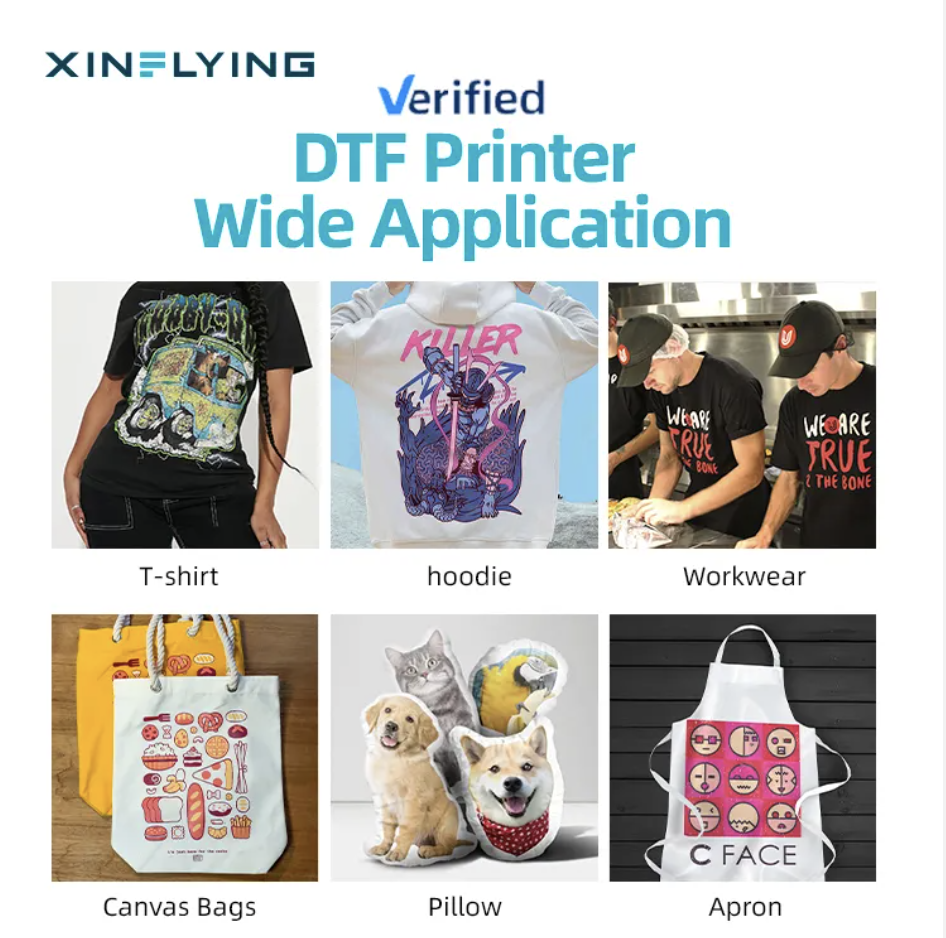
O'rganish va mastore
Birinchidan, DTF texnologiyasi o'rganish oson va master. Uy hayvonlari filmida suvga asoslangan pigmentli siyoh bilan chop etish qog'ozni chop etishga juda o'xshash, uni bosma do'konlar uchun osonlikcha qilish. Qo'shimcha, uni nisbatan kichik bo'shliqda amalga oshirish mumkin, uni barcha o'lchamdagi korxonalar uchun ochiq qilish.
Tez bosib chiqarish tezligi
Ikkinchidan, DTF bosib chiqarish texnologiyasi tez, Tez aylanish vaqtlariga erishish uchun PSP-ga ruxsat berish. Kollejni bosib chiqarish tugagach, uni o'tkazish uchun kerak bo'lguncha saqlanishi mumkin, ishlarni oldindan tayyorlash va boshqa usullar bilan ikki marta oq yoki CMYK bosib chiqarish zarurligini yo'q qilish uchun PSPS-ni yoqish.
Eng iqtisodiy jihatdan samarali jarayon
Bundan tashqari, vaqt DTF film va issiq yopishqoq kukun qo'shimcha xarajatlarga olib keladi, DTF ko'pincha eng tejamkor jarayon ekanligini isbotlaydi, Har xil o'lchamdagi psps-ga iqtisodiy foyda keltirishi.
Keng buyurtma doirasi
Nihoyat, Keng foydalanish oralig'i bosma kompaniyalar uchun turli bozorlarni ochadi. DTF bosib chiqarish texnologiyasi futbolkalar kabi umumiy kiyimlarni chop etish uchun ishlatilishi mumkin, qalpoqchalar, va sport kiyimlari, shuningdek, reklama buyumlari va hatto ichki bezaklar.
DTF va boshqalar. DTG bosib chiqarish
DTFni muhokama qilayotganda, Biz ham eslatib o'tishimiz kerak DTG. Hammasidan keyin; axiyri, Ikkalasi ham to'g'ridan-to'g'ri bosib chiqarish usullarini ishlatishadi.
DTG bosib chiqarish pul o'tkazmalarini yoki changni talab qilmaydi, Ammo bu xarajatlar ham ko'rib chiqilgan, DTF hali ham qimmatbaho xarajatlarni taklif qiladi. Qo'shimcha, DTF davolashdan oldin davolanishga muhtoj emas va turli tola turlari uchun mos emas. Nihoyat, Rang oralig'ida, Yaxshi tafsilotlar, va kiyim egiluvchanligi, DTF bosib chiqarish usuli noyob afzalliklarga ega.
DTF bosib chiqarish texnologiyasi kelajagi
Yuqorida muhokama qilingan nuqtalar joriy bozor takliflariga asoslanadi, Ammo kelajak haqida nima deyish mumkin?

Innovatsiyalar 2024 Fiz
Da 2024 Fiz, Biz DTF dalasida ba'zi yangiliklarni ko'rdik, Ishlab chiqaruvchilar va etkazib beruvchilar ko'plab qiziqarli voqealarni va'da qilmoqdalar. DTF bozoriga ta'sir ko'rsatadigan asosiy omillardan biri va barcha bosma tarmoqlar barqarorlikdir. Mijozlarning ekologik toza bosish uchun talabi oshmoqda, Ishlab chiqaruvchilar javob berishlari kerak, DTF domenida ko'rsatilgan.
Mimakining so'nggi takliflari
Mimaki oling, Masalan. Yaqinda ishlab chiqaruvchi yangi mimomaki txf300-75 ni e'lon qildi, paxtada chop etishga qodir, poliester, va poliester aralashmasi, shuningdek, engil va qora matolar, DTF va DTG bosib chiqarish dunyosining eng yaxshisini taklif qilish.
Yangi mashina ikki yillik ikki yillik kafolat bilan birga keladi va Oeko-Texex ECO pasporti tomonidan tasdiqlangan Mimaki siyohlaridan foydalanadi, Terim-do'stona va ekologik toza ishlab chiqarishga mijozlarning talabini oshirish.
Ushbu yangi model o'tgan yili Mimui DTF seriyasining dastlabki muvaffaqiyatlarini o'rnatishga qaratilgan. TXF150-75 sotildi 300 Evropadagi birliklar, Yaqin Sharq, va Afrika. Mimaki, eng so'nggi model avvalgi modellarga qaraganda uch baravar tezroq, Professional ommaviy kiyimlarni bezatish bozori uchun mo'ljallangan.
“Gibrid savdo direktori deydi, "TXF300-75 to'g'ridan-to'g'ri plyonka jarayonlarining tezkor o'sishini ko'rsatadi. Hozir, Muvaffaqiyatli TXF150-75 bilan bir qatorda ishga tushirildi, Bu kiyim-kechakni bezash bozorida kiradigan yoki kengayib borayotgan korxonalar uchun ko'proq tanlov taklif etadi.”
RA aqlli, shuningdek, DTF-ni qo'llab-quvvatlaydi, Politexning DTF Solutionsini tarqatish, DTF texnologiyasidagi kashshoflardan biri, botgan 2021.
RA Smartning hissasi
RA Smart-ning mahsulotni marketing bo'yicha menejeri Aleks Mudoll ushbu bozorni kengaytirish fohisha guvohnomasiga guvoh bo'ldi. U DTFning o'ziga xos texnologik ustunliklariga qaratilgan o'sishini va so'nggi yillarda ko'plab DTF platformalarining paydo bo'lishini ta'kidlaydi. Uning qo'shimcha qilishicha, yirik brendlarning oqimi faqat o'sishni davom ettiradi.
“Shubhasiz, DTF texnologiyasi juda yaxshi echimni taklif qiladi, Ammo nufuzli distribyutorlar bilan ishlash imkon qadar yangi texnologiyalarni o'rganish egrilayotganini minimallashtirish uchun juda muhimdir.”
Bozor tendentsiyalari va kelajakdagi prognoz
Bozor tendentsiyalari to'g'risida, RA aqlli DTF mashinalarida umumiy tendentsiyani aniqladi: Mijozlar uchun tezroq burilish vaqtlarini taqdim etish va mahsulotning xilma-xilligini oshirish uchun mahsulotning xilma-xilligini oshirish mumkin.
Uning ta'kidlashicha, yirik bosib chiqaruvchilar bir nechta mashinalar va samaraliroq tizimlarga sarmoya kiritmoqdalar, Shunday qilib, yuqori mahsuldorlik tizimlariga talab o'sishda davom etadi.
DTF printeriga sarmoya kiritishingiz kerakmi??

Shubhasiz, ko'p variantlar mavjud DTF printer mashinasi, Ammo sarmoya kiritish to'g'risida fikrlar o'zgaradi. DTF bozoriga kirish uchun, bitta variant - bu bilan hamkorlik qilish Professional to'qimachilik printerini ishlab chiqaruvchisi. Albatta, Bu biron bir foyda berishni anglatadi, ammo mashg'ulotlarga sarmoya kiritish va buyurtma berishni boshlash qiyin bo'lganidan qochishni anglatadi.
Shunday qilib, Bunga arziydimi?? Bu sizga nima qilishni rejalashtirganingizga bog'liq. Agar sizda mavjud mijozlar bilan shartnomalar bo'lsa, buyurtmalaringizga ishonadi, va ushbu texnologiyani eng yaxshi, Bu to'g'ridan-to'g'ri sho'ng'ish kerak bo'lishi mumkin. Boshqa tarafdan, Agar siz to'liq sodir bo'lishidan oldin suvlarni sinab ko'rmoqchi bo'lsangiz, Savdo sherigi bilan sheriklik ham yaxshi variant.
Xulosa
Yakunida, DTF bosib chiqarish texnologiyasi haqida gap ketganda, juda ko'p hayajonlanish kerak. Ushbu texnologiya nafaqat turli xil bosma mahsulotlarni ishlab chiqarishga imkon beradi, balki jadal rivojlanishini ham ko'rsatishi mumkin, O'z DTF mashinalarida bozorga kiradigan ko'plab yirik kompaniyalar bilan. Bu shuni ko'rsatadiki, biz bundan hatto ko'proq o'sishimiz va bu juda faol bozorda kengayishni kutishimiz mumkin.


